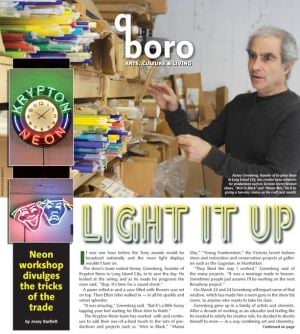Taschen Neon No.1, 2009. Borosilicate glass, argon gas, enamel, 200 mm x 650 mm x 200 mm.
Photo by The Crafts Council.

eep Neon and Carry On / 25–28 July / 650 GBP
2013 has only just got started, yet Neon Workshops have been busy
and can proudly confirm not one but two extraordinary four-day neon
courses now organised. The first: Keep Neon and Carry On, to be held at
the end of July, sees special guest artist Angus Powers (USA)
pushing experimentation in furnace glass and neon to the limits. The
four-day workshop, with support from Wheater & Bickerstaff, will be
all about experimenting and expanding perceptions of of what can be done with this media.
Evening events and presentations from tutors will argue why we should
hold onto neon and bring it into the 21st Century. The course will
include neon making and glass blowing. Experience is preferable but
not necessary.
Angus MacDiarmid Powers is the assistant professor of Glass
in the department of Sculpture at Alfred University, New York. As a
celebrated artist, he has exhibited and taught throughout the USA,
Europe and Scandinavia.
Moving Neon / 12–15 September / 565 GBP
Our second major neon workshop, Moving Neon, will be held
in September, focusing on animation of and kinetic movement with neon
light. To accompany his UK exhibition here this year, Los Angeles-based
neon artist Michael Flechtner
will be flying over to share the rare and often forgotten skills of
making neon move. Through an intense schedule of demonstrations,
hands-on practical exercises, discussions and presentations,
participants will be guided and inspired into making their own
sequencing neon art. Experience in working with neon and electronics is
not essential.
Michael Flechtner is a widely published and exhibited artist,
and has won numerous awards, including the J.Paul Getty Trust Fund
Fellowship in 1999. He is a board member for The Museum of Neon Art and
will be showing his first UK solo exhibition here at Neon Workshops 25
September–25 November 2013.
A schedule will be forwarded to participants ahead of the
workshops. Class will start at 10am and finish at 5pm, with a one-hour
break for lunch. On the glass blowing day (Friday) during the workshop
Keep Neon and Carry On, we will depart Neon Workshops at 7:30am in order
to be ready to start at 10am. For each workshop there will be three
evenings of presentations/events relating to the theme.
There are only eight places available on each of the two above
mentioned workshops, and we are accepting participants as of now on a
first-come, first-served basis. You can buy your workshop online with
Paypal or contact Neon Workshops for further info. Our online shop is fully up and running, where you can find workshop gift vouchers, limited edition prints, books and more.
The Workshops fee includes materials but not a neon power
supply/transformer. High-frequency neon transformers are available from
Neon Workshops at 65 GBP each. Food is not included in the workshop
fees. Neon Workshops is located in Wakefield city centre, where there
are a wide choice of food outlets. We can forward a recommended
accommodation list on request.
Beyond 2013…
Northern Lights
A landmark mobile neon workshop: Reykjavik, Iceland / February 2014 / 980 GBP
A four-day Mobile Neon Workshop taught by several artists working in neon and light of
international repute, plus evening events that will take place in
Reykjavik, including an excursion to seek out the Northern Lights during
February next near. Please get in touch if you are interested in being
part of this ultimate hands-on neon light experience.
Neon Workshops was set up in 2008 with an aim to expose, explore
and teach neon as a method of expression and cultural production, as
well as hoping to challenge common expectations of the material. Ideally
located between Yorkshire Sculpture Park, The Henry Moore Institute and the newly opened Hepworth Wakefield,
Neon Workshops is the only arts organisation in Europe and Scandinavia
to offer the general public a neon education, and exhibition programme
as well as facility hire.
Offering access to a high-spec neon facility, award-winning
neon makers and artists from all over the world are regularly invited to
teach and exhibit their work. Neon Workshops continues to help revive
neon both inside and outside of the gallery environment.






